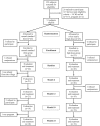Use of high-dose, twice-yearly albendazole and ivermectin to suppress Wuchereria bancrofti microfilarial levels
- PMID: 21039220
- PMCID: PMC3106228
- DOI: 10.1086/657063
Use of high-dose, twice-yearly albendazole and ivermectin to suppress Wuchereria bancrofti microfilarial levels
Abstract
Background: Annual mass treatment with albendazole and ivermectin is the mainstay of current strategies to interrupt transmission of Wuchereria bancrofti in Africa. More-effective microfilarial suppression could potentially reduce the time necessary to interrupt transmission, easing the economic burden of mass treatment programs in countries with limited resources.
Methods: To determine the effect of increased dose and frequency of albendazole-ivermectin treatment on microfilarial clearance, 51 W. bancrofti microfilaremic residents of an area of W. bancrofti endemicity in Mali were randomized to receive 2 doses of annual, standard-dose albendazole-ivermectin therapy (400 mg and 150 μg/kg; n = 26) or 4 doses of twice-yearly, increased-dose albendazole-ivermectin therapy (800 mg and 400 μg/kg; n = 25).
Results: Although microfilarial levels decreased significantly after therapy in both groups, levels were significantly lower in the high-dose, twice-yearly group at 12, 18, and 24 months. Furthermore, there was complete clearance of detectable microfilariae at 12 months in the 19 patients in the twice-yearly therapy group with data available at 12 months, compared with 9 of 21 patients in the annual therapy group (P < .001, by Fisher's exact test). This difference between the 2 groups was sustained at 18 and 24 months, with no detectable microfilariae in the patients receiving twice-yearly treatment. Worm nests detectable by ultrasonography and W. bancrofti circulating antigen levels, as measured by enzyme-linked immunosorbent assay, were decreased to the same degree in both groups at 24 months, compared with baseline.
Conclusions: These findings suggest that increasing the dosage and frequency of albendazole-ivermectin treatment enhances suppression of microfilariae but that this effect may not be attributable to improved adulticidal activity.
Figures







Comment in
-
Higher-dose, more frequent treatment of Wuchereria bancrofti.Clin Infect Dis. 2010 Dec 1;51(11):1236-7. doi: 10.1086/657064. Epub 2010 Nov 1. Clin Infect Dis. 2010. PMID: 21039221 No abstract available.
-
[Treatment of lymphatic filariasis by a double dose].Med Sante Trop. 2014 Jul-Sep;24(3):254-5. Med Sante Trop. 2014. PMID: 25580494 French. No abstract available.
References
-
- Meeting of the International Task Force for Disease Eradication-29 October 2008. Wkly Epidemiol Rec. 2009;84:89–94. - PubMed
-
- Addiss DG, Beach MJ, Streit TG, et al. Randomised placebo-controlled trial of ivermectin and albendazole alone and in combination for Wuchereria bacrofti microfilaraemia in Haitian children. Lancet. 1997;350:480–484. - PubMed
-
- Horton J, Witt C, Ottesen EA, et al. An analysis of the safety of the single dose, two drug regimens used in programmes to eliminate lymphatic filariasis. Parasitology. 2000;121((Suppl)):S147–S160. - PubMed
-
- Cartel JL, Spiegel A, Nguyen Ngnoc L, et al. Compared efficacy or repeated annual and semi-annual doses of ivermectin and diethylcarbamazine for prevention of Wuchereria bancroftifilariasis in French Polynesia. FInal evaluation. Trop Med Parasitol. 1992;43:91–94. - PubMed

